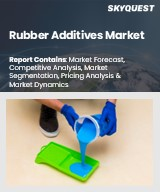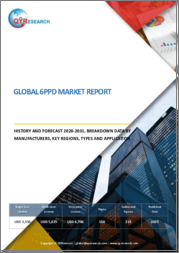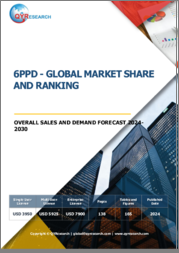
|
시장보고서
상품코드
1460141
고무 첨가제 시장 - 유형별, 용도별, 코팅제별 예측(2024-2032년)Rubber Additives Market - By Type (Accelerators, Activators, Peptizers, Plasticizers, Tackifiers, Vulcanization Inhibitors, Rubber Antioxidant, Insoluble Sulfur, Antidegradants), By Application, By Coating Agents & Forecast, 2024 - 2032 |
||||||
고무 첨가제 시장 규모는 제조업의 성장에 힘입어 2024-2032년 연평균 2.9% 이상 성장할 것으로 예상됩니다.
고무 첨가제는 내구성, 유연성, 내열성, 내화학성 등 제조 공정에 사용되는 고무 재료의 특성을 향상시키기 위해 기계, 전자, 섬유, 소비재 등 다양한 산업에서 다양한 용도로 고무 첨가제에 크게 의존하고 있습니다. 제조업에서 고품질 고무 제품에 대한 수요가 증가함에 따라 주요 제조업체는 생산 설비를 확장하고 있으며, 특수 첨가제에 대한 수요가 더욱 증가하고 있습니다. 예를 들어, 2023년 12월 러시아 석유화학 기업 Sibur's Nizhnekamskneftekhim은 할로부틸 고무(HBR) 생산 능력을 3분의 1로 업그레이드하여 150kt에서 200kt으로 늘렸습니다. 또한 경량화 추세와 제품 수명 연장으로 인해 고급 고무 첨가제 채택이 촉진되어 시장 확대에 박차를 가하고 있습니다.
고무 첨가제 산업은 유형, 용도, 코팅제, 지역별로 구분됩니다.
유형별로는 2024년부터 2032년까지 열화방지제 부문이 높은 수요를 보일 것으로 예상됩니다. 산화 방지제와 오존 방지제를 포함한 열화 방지제는 열, 산소, 오존 노출로 인한 고무 제품의 열화를 방지하는 중요한 첨가제입니다. 타이어, 자동차 부품, 산업용 벨트, 씰 등 다양한 응용 분야에서 고무의 내구성, 수명 및 성능을 향상시킵니다. 산업계가 제품 수명 향상과 유지보수 비용 절감에 주력하면서 고무 배합에서 열화 방지제에 대한 수요가 증가하고 있습니다. 또한 환경 보호 및 제품 안전에 대한 엄격한 규제는 고품질 열화 방지제의 채택을 촉진하고 있습니다.
용도별로 보면, 접착제 부문의 고무 첨가제 시장은 2023년에 큰 수익을 창출하고 2024년부터 2032년까지 높은 수요를 보일 것으로 예상됩니다. 고무 첨가제는 접착 강도, 내열성 및 유연성을 향상시켜 접착제의 성능과 내구성을 향상시키기 위해 선호되고 있습니다. 고무 첨가제는 자동차, 건축, 포장 및 전자 산업을 위한 접착제 제조에 필수적인 성분입니다. 또한, 자동차 및 항공우주 산업에서 가볍고 내구성이 뛰어난 소재에 대한 수요가 증가함에 따라 접착제 배합에 대한 제품 수요가 더욱 증가하고 있습니다.
아시아태평양의 고무 첨가제 산업은 2024년부터 2032년까지 강력한 성장세를 보일 것으로 예상됩니다. 이 지역에서는 자동차 부문의 호황, 인프라 개발 증가, 제조 부문의 확대로 인해 고무 제품에 대한 수요가 증가하고 있습니다. 또한, 건설 활동의 활성화와 건축자재에 대한 고무 수요 증가로 인해 제품 수요가 급증하고 있습니다. 중국, 인도, 일본이 고무 소비와 생산을 주도하고 있는 아시아태평양은 고무 첨가제 제조업체와 공급업체에게 더 많은 기회를 제공할 것으로 보입니다.
목차
제1장 조사 방법과 조사 범위
제2장 주요 요약
제3장 업계 인사이트
- 생태계 분석
- 기술 및 혁신 상황
- 규제 상황
- 업계에 대한 영향요인
- 성장 촉진요인
- 업계의 잠재적 리스크&과제
- 잠재 성장력 분석
- Porter's Five Forces 분석
- PESTEL 분석
제4장 경쟁 구도
- 기업 점유율 분석
- 경쟁 포지셔닝 매트릭스
- 전략 전망 매트릭스
제5장 시장 규모와 예측 : 유형별, 2018년-2032년
- 주요 동향
- 가속기
- 활성화제
- 펩타이저
- 가소제
- 점착 부여제
- 가황 억제제
- 고무 노화 방지제
- 불용성 유황
- 변색 방지제
- 기타
제6장 시장 규모와 예측 : 용도별, 2018년-2032년
- 주요 동향
- 접착제
- 전선 및 호스
- 절연 재료
- 특수 테이프
- Tier
- 기타
제7장 시장 규모와 예측 : 코팅제별, 2018년-2032년
- 주요 동향
- 실리콘
- 테플론
- 기타
제8장 시장 규모와 예측 : 지역별, 2018년-2032년
- 주요 동향
- 북미
- 미국
- 캐나다
- 유럽
- 독일
- 영국
- 프랑스
- 이탈리아
- 스페인
- 기타 유럽
- 아시아태평양
- 중국
- 인도
- 일본
- 한국
- 호주
- 기타 아시아태평양
- 라틴아메리카
- 브라질
- 멕시코
- 아르헨티나
- 기타 라틴아메리카
- 중동 및 아프리카
- 사우디아라비아
- 아랍에미리트(UAE)
- 남아프리카공화국
- 기타 아랍에미리트
제9장 기업 개요
- Arkema S.A.
- BASF SE
- Behn Meyer Group
- China Petrochemical Corporation
- Emery Oleochemicals
- Eastman Chemical Company
- Lanxess AG
- NOCIL Limited
- Sinopec Corporation
- Sumitomo Chemical
- Toray Industries, Inc.
Rubber Additives Market size is poised to expand at over 2.9% CAGR from 2024-2032 propelled by the expanding manufacturing sector.
Industries, such as machinery, electronics, textiles, and consumer goods rely heavily on rubber additives for various applications as they enhance the properties of rubber materials used in manufacturing processes, such as durability, flexibility, and resistance to heat and chemicals. With the rising demand for high-quality rubber products in manufacturing, major manufacturers are expanding their production facilities, further surging the need for specialized additives. For instance, in December 2023, Sibur's Nizhnekamskneftekhim, a Russian petrochemicals firm, upgraded its halobutyl rubber (HBR) production capacity by one-third, representing an increase from 150 to 200 kt. Additionally, the trend of lightweight materials and increased product lifespan is driving the adoption of advanced rubber additives, adding to the market expansion.
The rubber additives industry is segmented into type, application, coating agents, and region.
Based on type, the market size from antidegradants segment is projected to witness high demand from 2024-2032. Antidegradants including antioxidants and antiozonants, are crucial additives that protect rubber products from degradation caused by heat, oxygen, and ozone exposure. They enhance the durability, longevity, and performance of rubber in various applications, such as tires, automotive components, industrial belts, and seals. With industries focusing on improving product lifespan and reducing maintenance costs, the demand for antidegradants in rubber formulations is rising. Additionally, stringent regulations on environmental protection and product safety are propelling the adoption of high-quality antidegradants.
Based on application, the rubber additives market from the adhesives segment generated substantial revenue in 2023 and is estimated to witness high demand between 2024 and 2032. Rubber additives are gaining traction for enhancing the performance and durability of adhesives by improving bonding strength, heat resistance, and flexibility. They are essential ingredients in formulating adhesives for the automotive, construction, packaging, and electronics industries. Additionally, the rising trend of lightweight and durable materials in the automotive and aerospace industries is further boosting the product demand in adhesive formulations.
Given the regional landscape, the Asia Pacific rubber additives industry is set to exhibit robust growth during 2024-2032. The booming automotive sector, increasing infrastructure development, and expanding manufacturing sector in the region is creating a strong demand for rubber products. Additionally, the rise of construction activities, coupled with the growing demand for rubber in building materials is surging the product demand. With China, India, and Japan leading the way in rubber consumption and production, Asia Pacific will further present lucrative opportunities for rubber additives manufacturers and suppliers.
Table of Contents
Chapter 1 Methodology & Scope
- 1.1 Market scope & definition
- 1.2 Base estimates & calculations
- 1.3 Forecast calculation
- 1.4 Data Process
- 1.4.1 Primary
- 1.4.2 Data mining Process
- 1.4.2.1 Paid Process
- 1.4.2.2 Public Process
Chapter 2 Executive Summary
- 2.1 Industry 360-degree synopsis
Chapter 3 Industry Insights
- 3.1 Industry ecosystem analysis
- 3.2 Technology & innovation landscape
- 3.3 Regulatory landscape
- 3.4 Industry impact forces
- 3.4.1 Growth drivers
- 3.4.2 Industry pitfalls & challenges
- 3.5 Growth potential analysis
- 3.6 Porter's analysis
- 3.6.1 Supplier power
- 3.6.2 Buyer power
- 3.6.3 Threat of new entrants
- 3.6.4 Threat of substitutes
- 3.6.5 Industry rivalry
- 3.7 PESTEL analysis
Chapter 4 Competitive Landscape, 2023
- 4.1 Company market share analysis
- 4.2 Competitive positioning matrix
- 4.3 Strategic outlook matrix
Chapter 5 Market Size and Forecast, By Type, 2018-2032 (USD Billion, Kilo Tons)
- 5.1 Key trends
- 5.2 Accelerators
- 5.3 Activators
- 5.4 Peptizers
- 5.5 Plasticizers
- 5.6 Tackifiers
- 5.7 Vulcanization Inhibitors
- 5.8 Rubber antioxidant
- 5.9 Insoluble sulfur
- 5.10 Antidegradants
- 5.11 Others
Chapter 6 Market Size and Forecast, By Application, 2018-2032 (USD Billion, Kilo Tons)
- 6.1 Key trends
- 6.2 Adhesives
- 6.3 Electric cables and Hoses
- 6.4 Insulations
- 6.5 Specialty tapes
- 6.6 Tiers
- 6.7 Others
Chapter 7 Market Size and Forecast, By Coating Agent, 2018-2032 (USD Billion, Kilo Tons)
- 7.1 Key trends
- 7.2 Silicon
- 7.3 Teflon
- 7.4 Others
Chapter 8 Market Size and Forecast, By Region, 2018-2032 (USD Billion, Kilo Tons)
- 8.1 Key trends
- 8.2 North America
- 8.2.1 U.S.
- 8.2.2 Canada
- 8.3 Europe
- 8.3.1 Germany
- 8.3.2 UK
- 8.3.3 France
- 8.3.4 Italy
- 8.3.5 Spain
- 8.3.6 Rest of Europe
- 8.4 Asia Pacific
- 8.4.1 China
- 8.4.2 India
- 8.4.3 Japan
- 8.4.4 South Korea
- 8.4.5 Australia
- 8.4.6 Rest of Asia Pacific
- 8.5 Latin America
- 8.5.1 Brazil
- 8.5.2 Mexico
- 8.5.3 Argentina
- 8.5.4 Rest of Latin America
- 8.6 MEA
- 8.6.1 Saudi Arabia
- 8.6.2 UAE
- 8.6.3 South Africa
- 8.6.4 Rest of MEA
Chapter 9 Company Profiles
- 9.1 Arkema S.A.
- 9.2 BASF SE
- 9.3 Behn Meyer Group
- 9.4 China Petrochemical Corporation
- 9.5 Emery Oleochemicals
- 9.6 Eastman Chemical Company
- 9.7 Lanxess AG
- 9.8 NOCIL Limited
- 9.9 Sinopec Corporation
- 9.10 Sumitomo Chemical
- 9.11 Toray Industries, Inc.



















